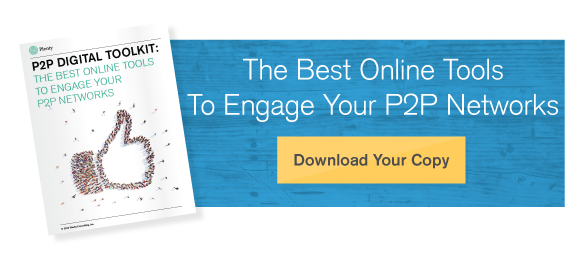Which Online Tools Do You Need First?
Feeling so overwhelmed by today's enormous assortment of online tools that you don’t even know where to begin? Or maybe you're still trying to sort out a tweet from a blog, or a post from a pin? If so, you’re hardly alone. Social media can be an unwieldy beast, but understanding how to leverage its full power to your advantage can help you best implement your fundraising strategies and reach your goals.
Let’s take a closer look at five sensible spots to start - from major players to rising stars - when it comes to making online tools work for you.
 1. Your Website
1. Your WebsiteIt may seem obvious, but your website is still the most important and effective online tool in growing your donor base. Your organization’s purpose should be clear from the get-go so that your audience can immediately understand your mission. For example, St. Jude Children’s Research Hospital writes on their homepage, “Finding cures. Saving children.” Stating your mission doesn’t get much clearer than that!
From there, craft your call to action - how can your audience help? What do you want them to do? What’s the first step they should take? Your website should be a tool to mobilize your audience and put them on the path towards taking action for your cause.
Throughout your website, make sure you have optimized the copy and design, and continuously update it as needed for the best results. Give people a reason to come back to your site - fresh content! Blogs, an event calendar, a spotlight on someone your organization is impacting, or even just a quote of the day can draw people back in. Use these pieces to build your nonprofit's narrative. Similarly, your website will be the first place your audience goes for information, and answering their common questions will go a long way in establishing trust while also saving your team valuable time that they could be devoting to other tasks.
All of this does nothing though if your website isn't easy to navigate. Whether it’s volunteering, starting a campaign, donating, all three, organize your website so that your users can perform the actions you want them to take in as few steps as possible (ideally, no more than three clicks).
One quick note: A recent collaborative study between the Case Foundation and Social Media for Nonprofits reveals that 88% of organizations report that their email communications and their website remain their most valuable communication tools. And with 47% of organizations citing “the pinnacle of engagement” with donors as the donation itself, it's no coincidence that these very donations are typically facilitated by websites and emails. Luckily, sites like Harvest & Donate.ly make it easier than ever to accept payments and donations online.
Recommended Resource: TechSoup’s “Spruce Up Your Website” toolkit, which walks you through every step of building your nonprofit website - from planning and designing to analyzing and improving.
2. FacebookEmit obligatory groan. Yes, by now it’s clear that Facebook is the place to be when it comes to making sure your organization and events are seen by the widest audience. Just how important is a Facebook “Like?” The average value of a single Facebook fan is just over $174, according to social marketing research firm Syncapse. Why do fans carry so much weight? Because they not only use the brands they like, but because they’re more engaged, loyal, and likely to invest - be it dollars, time, or advocacy.
For nonprofits, a Facebook page needs to be more than a place to post pictures from your latest event. Instead, invest in making it a valuable hub for your users. Make a strong first impression by creating high-quality images for your profile picture, cover photo, and any tab icons. Post on weekend mornings (using the native scheduling function) to take advantage of the times when engagement is highest on Facebook, and prioritize uploading photos over posting links (photos receive more engagement than other types of posts). Finally, increase cross-channel engagement by adding the Facebook icon to your website, email newsletters, and more.
Recommended Resource: This infographic by Shortstack illustrating 22 tips for nonprofits to succeed on Facebook.
3. MeetupWhen it comes to finding and building your tribe, Meetup offers an easy way to organize like-minded people around a particular event or social gathering. In fact, there’s an entire section of the website dedicated to nonprofit meetups, with over 300,000 members.
Handy segmentation tools mean you can isolate specific groups for targeted communications while an informal vibe keeps people feeling personally and organically connected. Your members can see all of your events and volunteer opportunities via a calendar tool, and the site uses Facebook integration so that users can see their connections to each other.
Start by narrowing down what you want to use Meetup for. Will you use a company Meetup page to highlight volunteer opportunities for your organization? To share events with constituents and encourage them to bring a guest? To simplify event registration? Or would your organization benefit more from joining other Meetup groups in your area and recruiting volunteers from there? Make sure that your Meetup strategy has a definitive focus for the most engagement. Explore charity: water’s Meetup page for ideas on how to engage volunteers on Meetup.
While organizers pay to use Meetup, its ability to target people with certain interests and demographics is incredibly valuable for nonprofits too. Meetup is also easy for trusted volunteers to set up and run - similar to Facebook, but more straightforward and with slightly less options.
Recommended Resource: Learn everything you need to know about using Meetup with a full tutorial from Lynda.com (don’t have a Lynda account? They offer a free 10-day trial).
Henry Ford once said, “Coming together is a beginning; keeping together is a progress; working together is success.” These online tools can help you bring all of the pieces together - not just to better serve your constituents, but to inspire them to serve you back.
Want more expert advice on how to use technology to grow your peer-to-peer networks? Download your copy of "The P2P Digital Toolkit" today which explores the best digital tools for engaging and growing your supporter networks!
Share this
You May Also Like
These Related Stories

How To Select The Right Social Media Platform For Your Brand

4 Digital Tools Every Nonprofit Needs For Growth




No Comments Yet
Let us know what you think